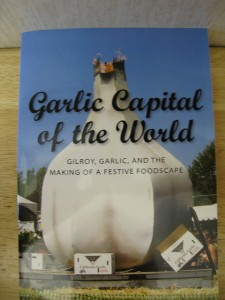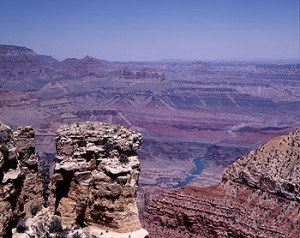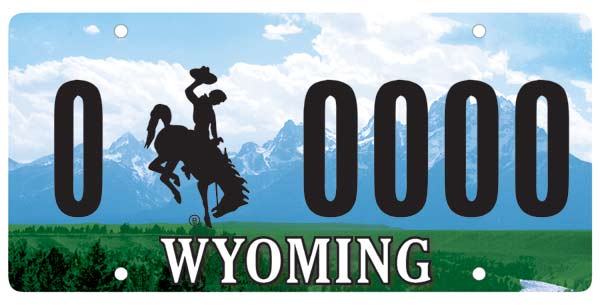I’m a Buckeye. Carol is a Gopher.
A buckeye is a nut, so I guess that fits me, but Carol is assuredly not a buck-toothed rodent.
Yet, since I’m from Ohio — the “Buckeye State” — and Carol’s a native of the “Gopher State” — Minnesota — you’d be safe in calling us by our vegetable and animal appellations.

Little Gilroy, California, gets a whole lot more visitors than it ordinarily would, just by calling itself the world’s “Garlic Capital.” (besighyawn, Flickr Creative Commons)
Indeed, Americans give nicknames to just about everyone and everything. I’ve always been a Ted, after all, not a Theodore to anyone but my mother, and she’s been gone for several years. And I call Carol “Carola” from time to time, even though that sounds like the name of a crayon.
New York City is the “Big Apple.” Dallas, Texas, is “Big D.” There’s even a “Cement City”: Allentown, Pennsylvania, which would make its mayor the Cement Head. Various cities in California are the Artichoke, Broccoli, Apricot, Raisin, Garlic, and Avocado “Capitals of the World.” A city in Michigan – Kalamazoo – is “Celery City.”
And you should hear some of the wild and wacky nicknames we give our college sports teams. I’m going to devote a whole blog to some of them later in the week. A teaser: One college’s squads are called the Aardvarks!
Today, though, how about a metaphorical hopscotch across all 50 of the nation’s states, which have some of the most historically interesting nicknames?
Alabama is known as the “Heart of Dixie” because of its location smack in the middle of a row of Deep South States. “Dixie” itself is a nickname for the American South. It got started when Louisiana printed notes with the French word for “ten” on them. “Dix” — “D-I-X” — led to “Dixie,” and Dixie to Dixieland music. But it’s Alabama, not Louisiana, that’s the Heart of Dixie.
Alaska, way up by itself next to northwest Canada, is called the “Last Frontier” for understandable reasons. Straddling the Arctic Circle, it was the final part of the nation to be explored and settled.

You can walk or ride a mule down to the Colorado River, far, far below the rim of the Grand Canyon. Either way, going down is scarier. (Carol M. Highsmith)
Arizona is the “Grand Canyon State” because of its awesome natural attraction, the winding canyon carved by the wild Colorado River.
The southern state of Arkansas calls itself the “Land of Opportunity.” This was strictly a promotional nickname chosen by the legislature. Though one of America’s poorest states, Arkansas is rich in natural resources and has become an affordable, and popular, retirement destination. Locals prefer to call it the “Razorback State,” after a lean and mean wild hog that roams the Ozark Mountains.
In a popular Spanish novel, a fictional island called “California” was filled with gold. Sure enough, in 1848 plenty of it was discovered in the real California, in what was then Mexican territory on the Pacific Coast. This triggered a gold rush unlike any other in American history. And it triggered the idea in the state capital of Sacramento that California’s nickname should be the “Golden State,” which it became and remains to this day.
You’d think Colorado would be known as the Rocky Mountain State, given its alpine location. But it’s the “Centennial State” because it attained statehood in 1876, exactly 100 years after the nation declared its independence.
Connecticut is called the “Nutmeg State,” but not necessarily because of the nutmeg spice — a precious cargo the state’s sailors used to bring home from trade journeys to Asia. Connecticut Yankees, as people in this northeast state are called, have a reputation for being shrewd in business. So shrewd that it was said they could sell phony wooden nutmegs to strangers.
Little Delaware earned its nickname as the “First State.” It was the first of the former British colonies to ratify the new United States Constitution.

The sun doesn’t ALWAYS shine on Miami Beach, Florida, but when it does, the sand, palm trees, and art deco architecture look awfully inviting. (Carol M. Highsmith)
Florida could be called the “Rain State” because of its tropical location. Or the “Expensive Beachfront Condo State” or the “Old Folks’ State” for its enormous population of retirees. Naturally, it prefers, instead, to accentuate its sunny days and fine beaches. So Florida is the “Sunshine State.”
Florida’s neighbor to the north grows some of the most succulent peaches in America. So naturally, if unimaginatively, Georgia is the “Peach State.”
Distant Hawaii, all by itself out in the Pacific Ocean, is the “Aloha” state, referring to the friendly greeting that means both “hello” and “goodbye” in the indigenous Hawaiian tongue.
Idaho is known as the “Gem State” — not because it’s laden with diamonds or emeralds but because it believes it’s the gem of the western Rocky Mountains. A few people call it “the Big Potato,” for its bountiful crop of spuds. Which of those nicknames would you choose if you were Idaho?

In this lithograph, Abraham Lincoln is shown returning to his Springfield, Illinois, home in 1858, after his famous series of debates with fellow U.S. Senate candidate Stephen A. Douglas. (Library of Congress)
Illinois is the “Land of Lincoln” — Abraham Lincoln, the martyred 19th-century president who started his political career in the midwestern state and later led the nation through a bloody civil war.
The Midwest state of Indiana is called the “Hoosier State,” but nobody is quite sure why. One story is that pioneer settlers were a little nervous opening the doors of their shacks and sod houses. “Who’s Zher?” they would say. No wonder the state legislature instead prefers to call Indiana the “Crossroads of America.”
Iowa’s nickname, the “Hawkeye State,” is a tribute to Black Hawk, a Sauk Indian chief who actually spent most of his life in neighboring Illinois!
The prairie state of Kansas also has a hawkish nickname: the “Jayhawk State.” Jayhawkers were ruffians who roamed the Kansas prairie during the turbulent years before the U.S. Civil War of the 1860s, when Kansans couldn’t seem to make up their mind whether or not theirs should be a slaveholding state. The bloodshed was so rampant before statehood that the territory was known as “Bleeding Kansas.” Perhaps “Sunflower State” or “Tornado State” — tornadoes are cyclones, which descend upon Kansas regularly, would make more sense.
The mid-South state of Kentucky is the “Bluegrass State.” Rich bluegrass, which is actually bright green but casts a bluish hue from a distance, nourishes the state’s renowned Thoroughbred horses.

You won’t get much of a footing in Louisiana’s Bayou Country. Even where there’s land among the swamps and streams, it’s soggy. (pop top lady, Flickr Creative Commons)
Louisiana is the “Bayou State.” Hundreds of these sluggish streams — many loaded with alligators! — meander through the Gulf Coast state.
Maine, up in the nation’s northeast corner, is the “Pine Tree State” because it’s virtually covered in evergreen woods. And directly across the country, the Pacific Northwest state of Washington has oodles of conifers as well. Washington is the “Evergreen State.”
The mid-Atlantic state of Maryland is called the “Free State,” but not because of giveaways or anything to do with slavery. A Baltimore newspaper first called it that during the 1920s, when the manufacture and sale of alcohol were banned for a time. Maryland said it wanted to be free to make and sell liquor.
Massachusetts is the “Bay State.” Its Atlantic inlet separates most of the state from famous Cape Cod, and its early settlers represented the Massachusetts Bay Colony.
Six state nicknames are taken from native animals:
Michigan is the “Wolverine State.” A wolverine is a small, burrowing mammal with a nasty disposition. Those who gave Michigan this nickname admired the critter’s ferocity.
Wisconsin’s badger is a similar and equally feisty creature, and Wisconsin is the “Badger State.”

Perhaps a little prayer will increase this gopher’s change of snagging a potato chip, which is certainly not part of its normal diet of roots and flower bulbs. (Dane Low, Flickr Creative Commons)
The gopher in Minnesota, the “Gopher State,” is much cuter and friendlier. The scurrying rodent builds mounds and tunnels on the prairie. But Minnesota license plates refer to the state, without exaggeration, as the “Land of Ten Thousand Lakes.”
North Dakota, on the Canadian border, gets its nickname, the “Flickertail State” not from some bird, but from a saucy little squirrel. And South Dakota takes its nickname, the “Coyote State,” from a fox-like predator that thinks flickertails are delicious! If you’ve seen the Wile E. Coyote cartoons, you know what I mean, only that miserable fellow had a taste for roadrunner birds.
And Oregon, the “Beaver State,” borrows its nickname from the large, flat-tailed rodent that gnaws trees until they tumble, then builds dams with the fallen logs.

Wish I could turn this into a “scratch and sniff” photo, for the fragile magnolia blossom smells divine. (zircon3035, Flickr Creative Commons)
Mississippi is the “Magnolia State,” for a tree with big, beautiful white blossoms that grows in profusion in that hot southern state.
Missouri is the “Show-Me State.” This refers to native skepticism and stubbornness for which the people of that Midwest state were once famous.
You have only to visit the gorgeous mountain and plains state of Montana to know why it is known as “Big Sky Country.”
Nebraska is the only state to adopt a nickname that salutes sports teams! The state university’s athletic teams are called “Cornhuskers” in recognition of one of the area’s chief crops. That nickname came first, and the state borrowed it.
The western desert state of Nevada is called the “Silver State” because it was once home to many silver mines and boomtowns — most of which are now abandoned ghost towns.
New Hampshire, in the White Mountains of New England, is the “Granite State. It’s replete with granite peaks and quarries.
New Jersey sits between the big cities of New York and Philadelphia — both in other states — and it got its nickname, the “Garden State,” because New Jersey truck farms once supplied vegetables to those sprawling cities.

For a lot of people in places like Albuquerque, Santa Fe, and Taos, New Mexico, this is an everyday afternoon treat on sunny days. (denise ~*~, Flickr Creative Commons)
If you get a chance to see a blood-red sunset over the Sangre de Cristo Mountains of New Mexico, you’ll know why that southwest state is called the “Land of Enchantment.”
New York, which always thinks big, was called the “Empire State” because of its natural wealth. The most famous Manhattan skyscraper took its name from the state. It is the Empire State Building, which the misunderstood ape, King Kong, climbed in the famous novel and movie.
North and South Carolina were one colony until 1729. South Carolina’s nickname is the easier of the two: It’s the “Palmetto State” because of the fan-leafed cabbage palmetto palm tree that grows there. (South Carolinians leave off the “cabbage” part, though.) North Carolina is the “Tar Heel State.” Its backwoodsmen, many of whom walked barefoot, would make turpentine out of tar and get the black, sticky tar on their heels.

The buckeye is quite an ordinary nut. Maybe it tastes better than it looks. (dcbprime, Flickr Creative Commons)
For some unknown reason, my “Buckeye State” of Ohio picked its nickname from a variety of chestnut. For school projects, we had to look long and hard to find any. Admittedly, we didn’t go too far into the countryside to look.
The Great Plains state of Oklahoma is called the “Sooner State,” because in a land rush in 1889, some people snuck into the territory early. They cheated and got there “sooner.”
Pennsylvania is called the “Quaker State” because its founder and most of his followers were members of the Protestant Quaker faith. Pennsylvania is also known as the “Keystone State.” Just as a keystone holds a stone arch upright, Pennsylvania was seen as holding together the young American republic.
Rhode Island — hidden between Connecticut and Massachusetts — is “Little Rhody” because of its tiny size. The state is smaller than the metropolitan area of Los Angeles, California.
Tennessee got its nickname — the “Volunteer State” — because of the valor of its citizens who volunteered to join Tennessean Andrew Jackson in defense of New Orleans, down in Louisiana, against the British army in the War of 1812.
Texas, the “Lone Star State,” gets its nickname from the single star on its flag, which represents its brief status as an independent nation after battling Mexico for sovereignty.
The “Beehive State” of Utah has no more beehives than any other state. The nickname derives from the Mormon Church’s symbol for industriousness. You’ll see beehives above store entrances and in the Utah state seal.
The northeastern state of Vermont is proud of its lush range called the Green Mountains. So much so that it calls itself the “Green Mountain State.”
Virginia is called the “Old Dominion.” It’s old by American standards, all right. Long ago, British King Charles II of England added the colony’s coat of arms to his shield, joining his other dominions of England, Ireland, and Scotland.
West Virginia, which broke away from Virginia in the 1860s, is simply the “Mountain State” because the ancient Appalachian chain runs right through it. So mountainous was West Virginia that entire cities were settled in places like Ohio to the west before a white person laid eyes on some of West Virginia’s remote valleys.
I saved perhaps the most American of state nicknames for last. The western state of Wyoming was once a trailhead for cattle about to be shipped east. And where there are cattle there are men — and now women — to herd them. Wyoming is the “Cowboy State.”
If they gave whole countries affectionate names, America’s might be “The Nickname Nation.”

Wyoming’s license plates salute not just cowboys, but rodeo cowboys in particular. Rodeos are a big entertainment draw in that rugged western state that has no major-league sports teams whatsoever.
Ted's Wild Words
These are a few words from this posting that you may not know. Each time, I'll tell you a little about them and also place them into a cumulative archive of "Ted's Wild Words" in the right-hand column of the home page. Just click on it there, and if there's another word that you'd like me to explain, just ask!
Hopscotch. A playground game on which children — or foolhardy adults — hop from square to square. It’s uncertain where the “scotch” part of the name came from, since the game was originally Roman and is played all over the world.
Oodles. Lots. This term may have begun with a rhyme: oodles of noodles. There can be one noodle, but there doesn’t ever appear to be a single oodle, however.
Spud. A nickname for the potato. As if often the case, there are many theories on the origin of this term. One is that it’s name for the “spudder,” a spade-like tool used to dig up potatoes.
Succulent. Moist and tasty. Full of juice.


